 |
|


All electronic donations will be
processed by PayPal
 
Nantucket/LV-112
Proudly made in USA
Attention
lighthouse lovers!
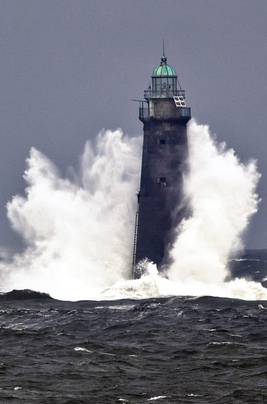 If you love lighthouses and want to learn about these guiding lights and navigational aids all over the world, then The Lighthouse Directory is the website for you. It provides an astounding amount of information, linking to more than 17,200 of the world's lighthouses. Russ Rowlett, Adjunct Professor of Mathematics at the University of North Carolina at Chapel Hill, compiled the directory with the assistance of hundreds of lighthouse fans around the world who have enriched this site with their own information and suggestions. For a long time, Rowlett tried to maintain a list of lighthouses from his many friends and contacts, but it had grown too long (and too out of date) to display on the comprehensive site. Rowlett offers special thanks to Michel Forand for his suggestions and editing, touching essentially every page of the directory, and Jeremy D'Entremont, Ted Sarah and Klaus Huelse, each contributing in vital ways. The Maine
Lighthouse Museum Another unique educational resource for U.S. Lighthouse history, Lifesaving and Lightship Services is the Maine Lighthouse Museum (MLM), located in Rockland, Maine, the heart of the Midcoast. Last October, the U.S. Lightship Museum presented a PowerPoint presentation at the MLM about U.S. lightships and Nantucket/LV-112. The mission of the Maine Lighthouse Museum is to educate the public regarding the longstanding traditions, heroism and progress of America's Lighthouse and Lifesaving Services and the U.S. Coast Guard through the conservation and interpretation of the nation's most significant collection of lighthouse and lifesaving artifacts. From sparkling lenses to heartwarming stories of the keepers and their families, the Maine Lighthouse Museum is truly America's lighthouse museum. For more information, log on to the Maine Lighthouse Museum or call 207.594.3301.
American Express
Amex Industrial Services, Inc.
Association of Public Safety Communications Officials - Atlantic Chapter
BAE Systems
Bluefin Robotics
Boston Forge & Welding Corp.
Boston Harbor
Shipyard & Marina
The Boston Foundation
ThreeBees Fund
Burnham Associates, Inc.
Burnham Marine
California Public Safety Radio Association
Cameron International Corporation
Charitable Adult Rides and
Services, Inc.
City of Boston
Community Preservation Act
C/J Towing & Recovery
Claflin & Son
Nautical Antiques
Crandall Dry Dock Engineers
Capt. Robertson P. Dinsmore Fund
Donahue, Tucker & Ciandella, PLLC East Boston Foundation Eastern Bank Charitable
Foundation
Egan Maritime Institute,
Nantucket Shipwreck &
Lifesaving Museum
Fitzgerald Shipyard
Foss Maritime
Friends of the
Boston Harbor Islands
H&H Propeller, Inc.
J. Hewitt Marine
Electrical Services
SR Johnson Fund
Kelly Automotive Group
H.F. Lenfest Fund
The Lightship Group, LLC
McAllister Towing &
Transportation Co.
Mediterranean Shipping Company
(MSC)
Joe and Pepette Mongrain
Fund
National Park Service
Save America's Treasures
National Trust for
Historic Preservation
New England
Lighthouse Lovers
New London Maritime Society and Custom House Maritime Museum
Patriot Marine, LLC
The Sail Loft, LLC, Nantucket
Sherwin-Williams
Industrial Marine Coatings Division
T & M Services
Town of Oyster Bay,
Long Island, NY
U.S. Coast Guard Lightship Sailors Association
West Marine
U.S. Lighthouse Society
Westerbeke Company
USLM Members
Verizon Foundation
Zuni Maritime Foundation
USS Zuni / USCG Tamaroa
Individual Donors
USLM is a member
of the following organizations
The flag of the United States Lighthouse Service
Teach children about lightships with the book
Lightship
Editorial From School
Library Journal
Kindergarten-Grade 2: Lightships were anchored where lighthouses could not be built. They protected our ocean harbors as well as points along the Great Lakes. The last one (Nantucket/LV-613) was decommissioned in 1983, so this fascinating picture book is a piece of nautical history. Brian Floca's watercolor drawings depict daily life aboard one of these vessels, cooking, sleeping, working, all the while rolling with the rhythm of the waves. Many hazards were involved. Big ships came too close, anchors lost their mooring, and weather caused many problems. But when the fog rolled in, the lightship sprang into action. Lights flashed and horns sounded, allowing ship traffic to make it "through fog and night, past rocks and shoals, past reefs and wrecks, past danger." The drawings are very detailed. Some pages are collages of small scenes. Many are full spreads. The sailors' facial expressions are amusing to watch, and the resident cat appears on almost every page. The front and back endpapers show a cutaway view of one of the vessels. This fascinating, little-known slice of history should prove interesting to every child who loves big boats.-- Ieva Bates, Ann Arbor District Library, MI (review originally published by Reed Business Information, Inc.) The book Lightship, by Brian Floca, can be purchased on Amazon.com. For more information about lightships, click on Brian Floca's blog.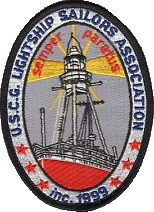 | |
For more information about the U.S. Coast Guard Lightship Sailors Association and the U.S. Lightship Service, click on logo
|
Lead, Kindly Light
By John Henry Newman (1801-1890) "Lead, Kindly Light, amidst th'encircling gloom,Lead Thou me on!The night is dark, and I am far from home,Lead Thou me on!Keep Thou my feet; I do not ask to seeThe distant scene; one step enough for me.I was not ever thus, nor prayed that ThouShouldst lead me on;I loved to choose and see my path; but nowLead Thou me on!I loved the garish day, and, spite of fears,Pride ruled my will. Remember not past years!So long Thy power hath blest me, sure it stillWill lead me on.O'er moor and fen, o'er crag and torrent, tillThe night is gone,And with the morn those angel faces smile,Which I have loved long since, and lost awhile!Meantime, along the narrow rugged path,Thyself hast trod,Lead, Saviour, lead me home in childlike faith,Home to my God.To rest forever after earthly strifeIn the calm light of everlasting life."Note: "Lead Kindly Light" was a poem originally written by John Henry Newman (1801-1890), who was 33 years old when he found himself on a boat from the Sicilian city of Palermo to Marseille, France. Newman, who was recovering after being dangerously ill with a fever, was on the boat to return to his native England when he penned the lyrics to "Lead, Kindly Light." The context that Newman was recovering from a frightening illness in the middle of the sea gives insight to the lyrics. Photo above: Pigeon Point Lighthouse in California, by Darvin Atkeson
Poem posted on
LV-112 while in service on Nantucket Shoals Lightship Station
"When a sailor gets to thinking He is one of the best
Let him ship out on a lightship
And take the acid test.
And if he feels like bragging
I don't think that all of his tales
Will be of deep sea sailing
But of the ship that never
Poem provided by Peter Brunk, USCG-Ret., Commanding Officer, Nantucket/LV-112, 1970-71, who serves on the USLM Board of Directors
|
This comprehensive New England shipwreck website is a helpful resource for SCUBA divers, maritime history researchers and enthusiasts. The site includes many photographs, charts, reference documents and history about many shipwrecks located in New England waters. For more information,
The Sinking of the U-853
by Capt. William Palmer
When the German enemy submarine U-853 entered U.S. waters off Portland, Maine in 1945, it torpedoed and sank the USS Eagle-56. Nantucket/LV-112, converted to an examination vessel, USS Nantucket (1942-45) during WWII, helped save the crew of the USS Eagle-56. This is a book about the U-853 story, researched and written by Capt. Bill Palmer, a long-time shipwreck researcher, diver and preservationist.
Description of book: "Out in the cold Atlantic Ocean off the coast of Rhode Island, lies the remains of what was once a feared and mighty hunter. It's not a fish or shark, for that matter it is not even a marine creature. It's what men feared the most when they went to sea aboard their vessel back during the World War II years. It's a German submarine called a U-Boat. The U-853 was the last German submarine sunk in World War II. She was sunk with all hands just minutes before World War II ended. The once mighty hunter feared by all who put to sea, now lies in 130 feet of water off the coast of Block Island, Rhode Island, her grave marked only by a circle on the nautical charts, DANGER Unexploded Depth Charges, May 1945."
Capt. Palmer has been running a charter boat for wreck-diving, shark-fishing and shark-cage-diving off the coast of Rhode Island and Connecticut for 40 years.
German U-boat attack off Portland, Maine, during WWII, involving
LV-112 (USS Nantucket)
This book is the story of a small U.S. sub-chaser, the Eagle 56, caught in the crosshairs of a German U-boat, the U-853, whose brazen commander doomed his own crew in a desperate, last-ditch attempt to record final kills before his country's imminent defeat a few weeks later in May. And it is the account of how one man, Paul M. Lawton, embarked on an unrelenting quest for the truth and changed naval history.
For more information, log onto: "Due to Enemy Action"

"In February of 1952, one of the worst storms to ever hit the East Coast struck New England, damaging an oil tanker off the coast of Cape Cod and literally ripping it in half. On a small lifeboat faced with frigid temperatures and 70-foot high waves, four members of the U.S. Coast Guard (Bernie Webber and three other crewmen) set out to rescue the more than 30 stranded sailors trapped aboard the rapidly sinking vessel. 'The Finest Hours' is the story of their heroic mission, which is still considered the greatest small boat rescue in Coast Guard history."
(Michelle McCue, 9/9/14)
Bernie Webber (later served on Nantucket/LV-112, 1958-60) and the three other crewmen were awarded the coveted USCG Gold Lifesaving Medal for their heroism in what is considered by maritime historians to be "the greatest small boat rescue in Coast Guard history." Mr. Webber, who was a member of the USCG Lightship Sailors Association, was extremely helpful in assisting the USLM-Nantucket/LV-112 compile research information and historic documents about LV-112. He was a pleasure and honor to work with. Bernie passed away in January 2009. He was considered "A Real American Hero" and is dearly missed.
|
| |
The full length movie "The Finest Hours' is available on DVD.
|
To learn more about
lighthouse news, click on
Lighthouse Digest

Explore the oceans in depth and Woods Hole Oceanographic Institution with
Oceanus magazine
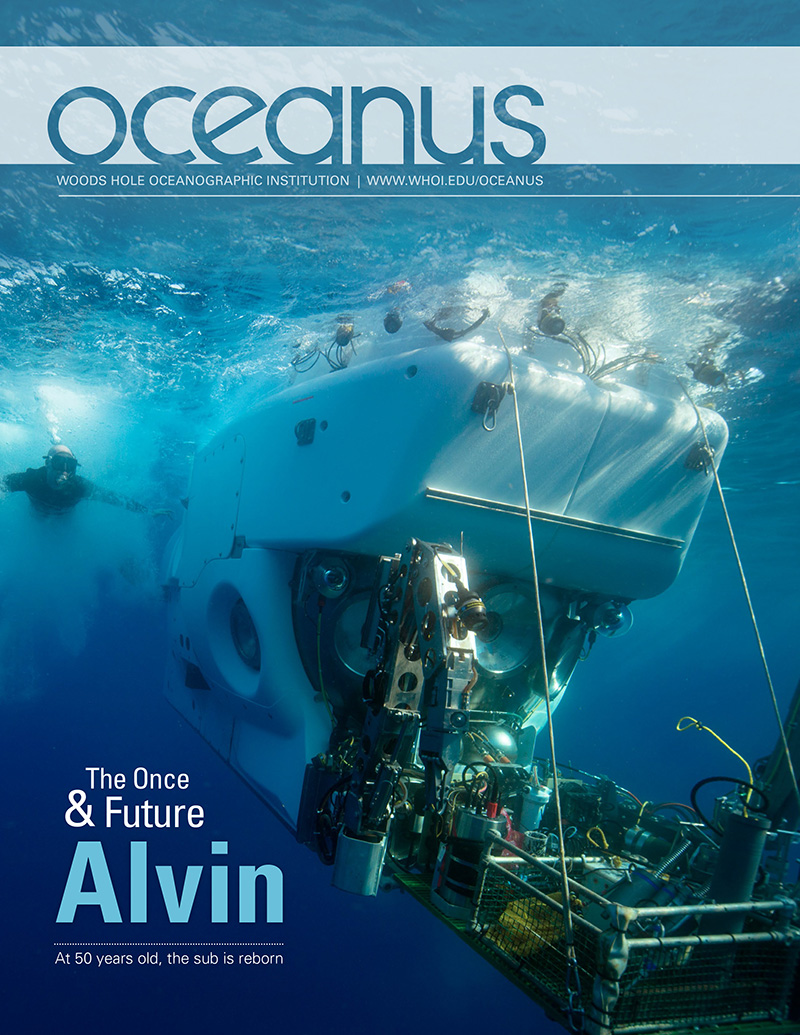 Oceanus explores the oceans in depth, highlighting the research and researchers at Woods Hole Oceanographic Institution in news, features and interviews written by magazine staff, with full-color photographs and illustrations. Each issue covers a wide spectrum of oceanography, spanning coastal research, marine life, deep-ocean exploration and the ocean's role in climate, as well as ocean technology and policy. To learn more, click on magazine cover above.
Lightships, Lighthouses & Lifeboat Stations:
A Memoir and History
Lightships, Lighthouses & Lifeboat Stations is part history book, part memoir, written by Bernie Webber, recipient of the Coast Guard's highest award, the Gold Life-saving Medal, and hero of the Disney movie The Finest Hours. While the public will recognize Webber's name from the movie and the bestselling book by the same name, few people know that during his lengthy Coast Guard career he served on lightships (ships anchored in dangerous areas to warn other vessels of hazards) in addition to lifeboat stations (small boat rescue stations) and lighthouses. Webber poses the following question: "How did the lightship men cope with the isolation, constant loneliness, boredom, fear, or just sheer terror? All were part of life on board a lightship. Rough seas tossed the ship about, rearing up and down on the anchor chain. This was a world of isolation, noise from operating machinery, and blasts from the powerful foghorn that went on for hours, sometimes days, at a time." Webber answers that question in this book, drawing on a combination of personal experience and meticulous historical research. Discussions of men going mad, lightships being run down by larger ships, anchor chains breaking, and lightships cast upon shoals are offset by humorous stories and the author's reflections on his best days at sea. Fourteen historic photos are included, as well as a foreword by Michael Tougias.(reprinted from Amazon).
Help support the restoration of LV-112 by donating your old car and receive a tax deduction
How it works
We have teamed with Charitable Auto Resources, Inc. (CARS), to accept vehicle donations across the United States. Once you contact our customer service representative about making a donation, everything will be taken care of, including a receipt for your tax records. Sale proceeds will be donated to the USLM in your name. Donating your vehicle to the U.S. Lightship Museum is as easy as calling our representative toll-free at 855-500-7433. For more information, click here.
The Lightships
of Cape Cod
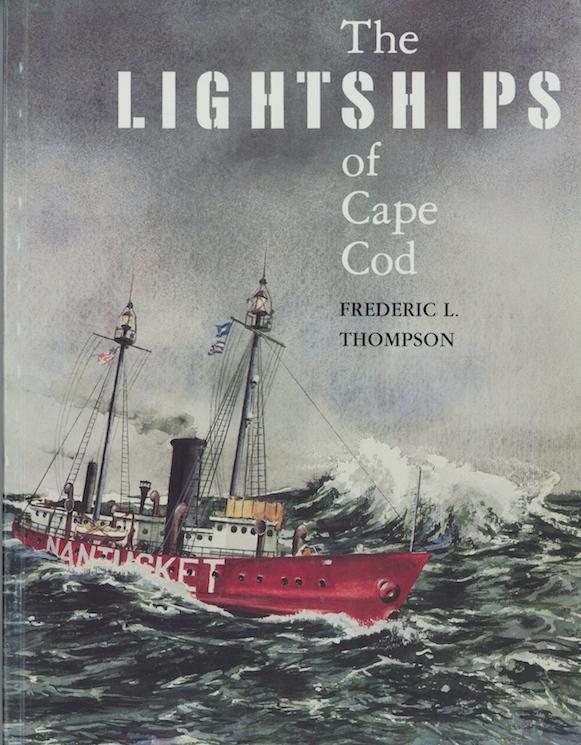
Authored by Frederic L. Thompson, 1996, 2nd printing, 112 pages, soft wrap. Signed by the author. Illustrated with over 93 beautifully detailed photographs. Much sought-after, this scarce volume chronicles the history of the lightships in this vital area. Wonderfully detailed black-and-white photographs enhance the author's vivid description of the history and life aboard these vessels. One of the only volumes ever written exclusively on this subject, this fine work will make a fine addition to any library. Price: $14.95 plus shipping ($5.95), total: $20.90. May be purchased online
from the USLM; just click on "Donate" button in this newsletter and add a notation in the area provided. Or mail a check or money order addressed to: U.S. Lightship Museum, PO Box 454, Amesbury, MA 10913
Massachusetts Lighthouses and Lightships
"Massachusetts Lighthouses and Lightships" by Arthur P. Richmond is an indispensable addition to the lighthouse enthusiast's library, required reading for those interested in New England maritime history, and a delight for anyone who enjoys coastal Massachusetts. More than 800 images, many never before published, include historic plans that describe the details of these aids to navigation, and archival and contemporary photos that trace through their history. The book covers all the lighthouses and lightships that marked the shores (exclusive of Cape Cod and the Islands) and guided mariners through the challenging waters surrounding Massachusetts. This volume also explores the interiors of towers, shows the lantern rooms of rarely-visited lighthouses, and gives fascinating facts about these beacons through their 200-year history. U.S.Lightship Museum (USLM): Excellent book-one of the better books published, about lighthouses and lightships. Credit: Review-Amazon Books/USLM
U.S. Lightship Museums
|
| |
A crew member rings the bell on the foredeck of Nantucket New South Shoal No. 1 during low-visibility storm conditions. The llustration is from "Life on the South Shoal Lightship" by Gustov Kobbe, Century Magazine, August 1891
|
Kenrick A. Claflin & Son Nautical Antiques
Click on the website link above to see nautical artifacts available at Kenrick A. Claflin & Son Nautical Antiques, which has donated publications to the USLM.

|
|
|
|
|
[Note: To see entire eNews, click link above newsletter]
'Tis the season for summer weather, and with it, the specter of tropical storms and hurricanes
|
| |
Nantucket/LV-112 glows during a lightening storm while berthed in Oyster Bay, Long Island, NY, sometime prior to 2009, before the U.S. Lightship Museum (USLM) assumed ownership. Notice the radio beacon antenna top masts are shorter than they are today. To retain historic accuracy, the USLM has restored the radio beacon antenna top masts and radar antenna railings back to their original 1975 U.S. Coast Guard (USCG) configuration.
|
|
| |
On station, Boston Lightship/LV-118 crew member Rick Dasch stands on the auxiliary mushroom anchor, preparing to cool off in the chilly Atlantic during the summer of 1965. Boston/LV-118 is presently a lightship museum (renamed OVERFALLS) berthed in Lewes, DE.
|
|
| |
The transatlantic passenger steamer RMS Adriatic fights stormy seas, heading into New York Harbor from Liverpool, England, c. 1885. The RMS Adriatic was built in 1871 for the White Star Line and regularly steamed to and from New York and Liverpool. Nantucket/LV-1, guided the Adriatic's transatlantic's voyages her entire career. LV-1 was stationed on Nantucket Shoals Lightship Station from 1855-92. Painting: George Parker Greenwood, 1889
|
The summer weather traditionally brings much joy to many. Unfortunately, with it, is enduring the specter of hurricane season for the Atlantic basin (June 1 to November 30: Atlantic Ocean, Caribbean Sea, and Gulf of Mexico). As you may already know, lightships and their crews were required to remain on station, regardless of the weather. From 1854 to 1983, Nantucket Lightship Station experienced 35 New England hurricanes and tropical storms, in addition to many winter and spring storms at sea. The anniversary of LV-112's battle with Hurricane Carol (8/31/1954) and Hurricane Edna (9/11/1954) is just around the corner.
|
| |
Nantucket/LV-112 during storm conditions on Nantucket Shoals Lightship Station during the infamous 1938 hurricane in New England. The great Atlantic hurricane of 1944 sank the Vineyard Lightship, killing all 12 crew members aboard.
|
"Nantucket Lightship S.O.S. - listing bad"..."We will go down with the ship rather than desert this station"
- LV-112 Chief Boatswain, John Corea, 9/11/1954
It was reported by former USCG LV-112 crew members that during Hurricane Edna, Nantucket/LV-112 was constantly battered by monstrous seas, listing more than 60 degrees at times. In fact, former LV-112 crew member Albert DiFlumeri (USCG 1954-56) recounted going on board LV-112, right after being towed into USCG Base Boston after the storm and seeing footprints on the crews quarter's bulkheads (vertical walls).
|
| |
The large solid bronze wheel in LV-112's pilot house was ripped off the helm station when a storm wave from Edna crashed through the almost 1-inch-thick glass pilot house portholes. Richard E. Arnold (left), who was at the helm when the wave crashed through the pilot house, throwing him against the bulkhead during the time of the incident, survived his injuries. He is shown with Engineering Officer Eugene W. Darcy (center) and Skipper John C. Corea (right).
|
|
| |
USCG LV-112 crew member holding destroyed flying bridge wheel, caused by Hurricane Edna.
|
|
| |
Richard Arnold on LV-112's flying bridge surrounded by wreckage caused by Edna. The damaged helm station, binnacle (lying on deck) and search lights were ripped from their deck mounts during the storm.
|
|
| |
LV-112 crew enjoying a meal in the crew's quarters on station, prior to Hurricane Edna.
|
During Hurricane Edna, LV-112 suffered major damage to her hull and superstructure. The largest U.S. lightship ever built also lost power and the ability to steer, after the lightship's anchor chain broke from its mooring. This caused LV-112 to aimlessly drift, coming the closest to foundering during her 39-year career as a commissioned U.S. lightship, serving on Nantucket Shoals Lightship Station and WWII examination vessel (1942-45). Disabled by the storm, LV-112 had to be towed back to Boston (26-hour tow, 180 miles) from Nantucket Shoals Lightship Station, 100 miles from the U.S. mainland. After repairs were made, LV-112 headed back to her station under her own power. Click here to read 1954 newspaper account of incident.
|
Nantucket/LV-112's anchor lantern, damaged from Hurricane Edna, is donated to USLM
|
| |
LV-112's lantern was previously used as an electrified residential yard lamp, as seen in photo at left. After recovery and cleaning, shown at right, LV-112's lantern unfortunately shows evidence of the ravages of time and hard service at sea and retirement. Notice damaged portion of lantern, caused when the lantern was blown off LV-112's forestay and crashed to the weather deck during Hurricane Edna. Amazingly, the well-built lamp's Fresnel lens did not break upon striking the weather deck during the storm.
|
|
| |
LV-112's lantern can be seen mounted on the Nantucket's forestay prior to Hurricane Edna. We believe the lantern was installed in 1936 when LV-112 was built. The Perko lantern is constructed of steel with a galvanized plating. In addition, the lantern was originally fueled by kerosene and converted to electric power while in service on LV-112. The original chimney and bottom vents on the lantern were sealed when electrified.
|
|
|
LV-112's anchor lantern is stamped with the manufacturer's brass label: "Perkins Marine Lamp & Hardware Corp. PERKO Brooklyn, NY U.S.A." Perkins was founded in 1907 and still manufactures marine navigational lights today. The privately owned fourth-generation family-owned corporation is presently based in Miami, FL. For more information about the Perkins Corp.'s unique founding and family history, click here.
|
 |
|  |
LV-112's anchor lantern originally looked like the lamp in the above photo (except with a clear lens) when it was fueled by kerosene.
|
Paul Mendez, the nephew of former Nantucket Lightship/LV-112 Skipper John C. Corea (1910 -2007), generously donated LV-112's anchor lantern to the U.S. Lightship Museum (USLM). Chief Corea had given it to Paul as a souvenir. Paul then mounted it on a pole, electrified it and used it as a yard lamp. Chief Corea was a 21-year veteran of the USCG from Provincetown, MA. His nephew Paul is also from Provincetown and presently resides there. Paul also kindly donated other memorabilia from his uncle to the USLM. To view an album dedicated to Chief Coria's service in the USCG, click here. The USLM would like to extend its gratitude to Paul Mendez for his generous donation of LV-112's lantern and his uncle's USCG memorabilia.
|
Nantucket Lightship/LV-112's phase 2 restoration is underway
LV-112 visitors enjoy a ship tour prior to the COVID-19 pandemic.
As a result of the COVID-19 situation and LV-112's current phase of restoration, tours, special events and educational programs on the Nantucket have been temporarily discontinued during the 2020 season. Recently, in Massachusetts, museums have been allowed to open to the general public. As a result of LV-112's present phase of restoration, limited tours open to the public are only available by scheduled appointment. In addition, LV-112 is being prepared to be transported for dry-docking to the Fitzgerald Shipyard in Chelsea (Boston Harbor) on August 18. In addition to Fitzgerald Shipyard, the following marine contractors are involved with LV-112's current phase of restoration: The Lightship Group, LLC; AMEX Industrial Services Corp.; Bristol Marine; Marine Surveyors/Ocean Technical Services, LLC; 72 Hours, LLC; Charles C. Deroko, Inc.; and Engineers/Marine Systems Corp. (MSC). The following photos illustrate some of LV-112's restoration in progress. For more information about scheduling a tour, please call 617.797.0135 or send an email (click here).
|
|
A recent work party included many local East Boston community volunteers, who generously donated their time to help the USLM off-load the remainder of items from LV-112's storage holds to make way for restoration. As seen in the photo, a "bucket-brigade" method was utilized for efficiency and ease of handling objects. Many of our helpers also are volunteers with East Boston's nonprofit Eastie Farm organization. For more information about Eastie Farm, click here.
|
|
| |
LV-112 volunteers (left to right) Dave Pippin, John Rogers and Jim Hewitt take a break for the camera in the anchor windlass room.
|
|
| |
For many years, a number of areas throughout the interior of LV-112 leaked water during heavy rainstorms and the melting of winter ice. The leaks previously were temporarily repaired but finally failed. As a result, these areas through the years caused corrosion and damage to the steel deck plating. In recent months, all the areas that leaked were located and have been properly repaired; no more rain water leaks! LV-112's fog-horn room steel deck, adjacent to the door entrance, also was badly corroded and leaked water during rainstorms into the galley below. The corroded deck was cut out to be replaced with new steel. With the deck section cut out, you can see through to galley below.
|
|
| |
A new steel section was cropped into deck and welded.
|
|
| |
Volunteer Jim Hewitt (left) upgrades electrical connections in the main service panel in LV-112's pilot house. Matt Moretti (right), deep inside LV-112's fresh water tank, fabricates and welds new sections on the tank access ladder.
|
|
| |
LV-112's anchor windlass room after a recent restoration, where the main and auxiliary mushroom anchors are lowered and raised. The anchor windlass was originally powered by steam. In 1960, LV-112's original, 600HP compound reciprocating steam engine was replaced by a 900HP, 8-cylinder Cooper-Bessemer diesel engine. The windlass is now powered by compressed air. Amex Industrial Services, headquartered in East Boston, cleaned, prepped and painted the anchor windlass room.
|
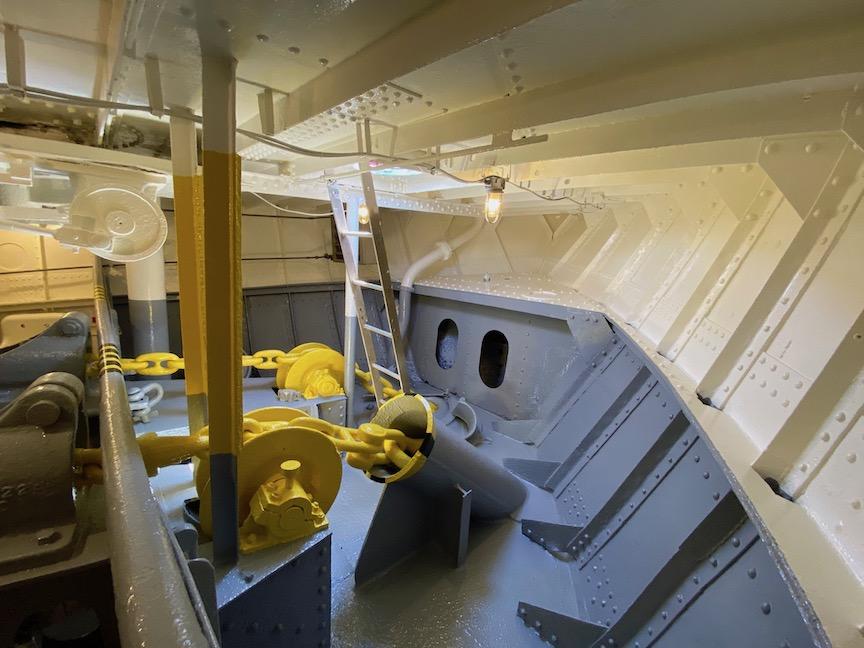
|
| |
Marine contractors Sean Harrigan and Matt Moretti, from The Lightship Group, LLC, dismantle LV-112's cast iron anchor windlass capstan to rebuild its wood-planked pad/base, which had deteriorated from age and wear.
|
|
| |
The capstan pad originally was constructed of heavy longleaf yellow pine planking that was bolted to LV-112's steel weather deck. As old as it was, after being exposed to extreme weather for 84 years, the pine still had an overwhelming turpentine odor from the resin in the wood.
|
|
| |
LV-112's anchor windlass capstan was carefully removed, documented and reassembled for transport to Bristol Marine, to be used as a template. In addition, LV-112's original 1936 blueprints of the capstan pad were located and are being used. Transporting the capstan pad in the vehicle smelled like transporting leaking turpentine containers, requiring a lot of fresh-air ventilation.
|
The original capstan pad was constructed of longleaf yellow pine, commonly used many years ago in wood-constructed commercial ships such as large cargo schooners and the construction of mill buildings in the Industrial Revolution era. The USLM has contracted the Bristol Marine shipyard in Boothbay Harbor, ME, to construct the pad with the same type of wood. Bristol Marine's staff includes talented shipwrights who are still utilizing traditional shipbuilding methods and skills, used in rebuilding and restoring historic wooden ships.
|
| |
Eric Graves, on the deck of the Ernestina-Morrissey, is shipyard manager for Bristol Marine, Boothbay Harbor, ME.
|
In fact, they are presently under contract to restore and rebuild the 152-foot (LOA) two-masted schooner Ernestina-Morrissey, a National Historic Landmark, built in 1894 in Essex, MA. The late philanthropist Gerry Lenfest (1930-2018), a committed financial donor to historic maritime preservation projects, was a generous donor to Nantucket/LV-112 and to the current Ernestina-Morrissey project. He also was personally involved with the operation of the Bristol Marine shipyard. For more information about the Ernestina-Morrissey restoration project and Bristol Marine, click here.
|
AMEX Industrial Services donates restoration of LV-112 artifacts
|
| | Metal storage containers that were kept on board LV-112 while a commissioned USCG lightship held extra maintenance parts such as electronic, electrical, plumbing and engine parts. The steel boxes had never been restored and had a lot of exterior surface rust on them. There were a total of 16 boxes of various sizes. Each of the boxes was full of extra new old-stock parts (NOS), many with unopened packaging, dating back to 1946. AMEX generously offered to clean, prep and repaint the boxes, as shown in photo with an unrestored box. The final step in the restoration is to paint the boxes with historically accurate letter stenciling, identifying the contents in each box. |
|
| |
Several NOS items were found in the storage containers. All the discovered items were "Made in the USA," such as many of the electrical parts manufactured by General Electric in Schenectady, NY, and the brass plumbing valve manufactured in Port Huron, MI. We also found U.S. Navy Morse code signaling searchlight components from LV-112's (USS Nantucket) service during WWII.
|
|
| |
Nantucket/LV-112 has been a treasure trove of unique historic artifacts. In photo are a Bridge Log dated from 12/27/72 to 1/31/73, a handcrafted whisk broom created from a single piece of 3/4-inch Manila hemp rope, and a book of unused matches from the former Boston Harbor "landmark" seafood restaurant, Jimmy's Harbor Side Restaurant, previously located on the waterfront now called the Seaport District. We suspect that the broom was handcrafted by one of the former LV-112 sailors while on station.
|
In addition to the many NOS parts discovered, throughout the years of cleaning out LV-112, many original documents, ship logs, blueprints, shark jaws (from sharks caught by former crew members), galley recipes, dish ware, cooking utensils, tools and even personal makeshift sea sickness receptacles also were discovered. Nantucket Lightship/LV-112, is a virtual floating time capsule that offers great educational opportunities. More to come in the next issue of the USLM eNews.
|
|
A virtual celebration of National Lighthouse Day, August 7
|
| |
Click the arrow above to see and hear Nantucket/LV-112 on National Lighthouse Day. When the USLM acquired LV-112 in late 2009, it was a "dead ship"; nothing was operational on the historic floating lighthouse. As a result of donors' generous contributions, the USLM has brought LV-112 back to life. Today, a majority of the ship's onboard systems are in working order, including its powerful foghorn and main rotating light beacon, designed to be seen 23 miles at sea.
|
|
|
Support LV-112's restoration!
Become a USLM member today
|
| |
For a gift of $1,000 or more, donors will receive a limited-edition, fine-art print of the SS United States passing Nantucket/LV-112, signed by marine artist Gerald Levey.
|
Discover the value-added membership benefits when you become a member of the U.S. Lightship Museum (USLM). The USLM is a member of the Council of American Maritime Museums (CAMM). All USLM members will be granted reciprocal privileges (free admission) at participating CAMM institutions. For more information about the benefits and the USLM Membership program, click on USLM Membership.
All electronic donations will be processed by PayPal.
We thank everyone for their ongoing
contributions and support
|
|
|
|
|
|
|
|